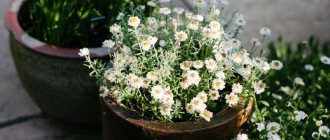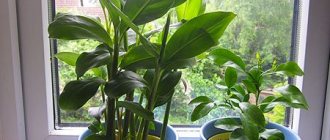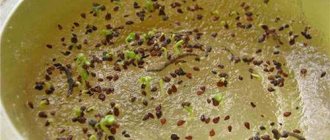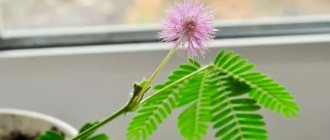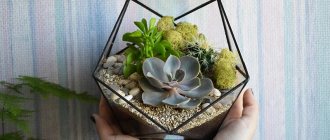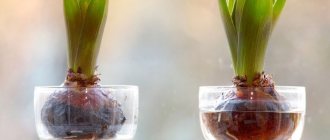Even if you have a suburban area, it only brings fresh greenery in spring and summer. To extend the harvest season, you can place a mini-garden in your apartment on the windowsill or on the balcony. Let's try to figure out which cucumber seeds are suitable for growing in the window, when tomatoes in pots ripen, and what unusual things can be grown in a home greenhouse. You will also find photos and names of your potential pets in our article.
Advantages and disadvantages
By arranging a vegetable garden at home on the windowsill, you can get not only “vitamins on the window”:
- you always have spicy herbs at hand for the table - and you don’t need to think about how to keep them fresh;
- the leisurely work of caring for a mini-garden calms you down and distracts you from the hustle and bustle;
- plants create a special microclimate, purify the air, regular watering increases the humidity of dry air;
- You can keep your child busy and awaken his interest in biology.
But not everything is so rosy:
- You should be careful with fertilizing, as its excess can accumulate in the upper part of the plant;
- There are much fewer vitamins in indoor vegetables than in those grown outdoors;
- working with soil brings a lot of trouble with cleaning.
Greenery
Growing greens is quite simple if you create comfortable conditions for the fragrant herbs. On an industrial scale, the hydroponic cultivation method is used. If you wish, you can purchase a small hydroponic system for your home.
In summer and winter, the following grow from the greenery on the windowsill:
- dill varieties “Gavrish”, “Aurora”, “Ozornik”, “Alligator”, “Gribovsky” produce a thick green mass;
- cilantro (coriander) - household members may not like the specific smell; it is better to place the plantings on the balcony;
- spinach - “Fatty leaf”, “Matador”, “Victoria”, prefers coolness, at 20–25 ° C it begins to shoot out;
- sorrel - grows on any soil, likes regular watering;
- purslane - a vegetable variety distinguished by small flowers, grows on poor soil, with a lack of moisture the leaves become smaller;
- parsley is an unpretentious plant, the leaf provides spicy herbs, the root provides herbs and root vegetables;
- marjoram can grow on a window all year long if it is not exposed to the sun in summer;
- watercress - early varieties like “Dukat” grow back in 2-3 weeks;
- chard is a biennial plant that produces fragrant leaves in the first year;
- arugula (indau) - varieties “Azart”, “Fast-growing” are drought-resistant, ready for consumption 2 months after sowing.
Growing and caring for them is not difficult even for a child. The soil for greens must be nutritious to ensure rapid growth. Fertilizing of greenery is carried out after cutting, strictly following the instructions.
Sowing dill seeds can be done in the ground from the garden, but for watercress it is better to buy clean soil to avoid flea beetles.
In order not to sow parsley, in November they dig up the root and plant it in a deep pot. With the onset of winter, it slows down its growth, but in February the leaf mass begins to increase.
How often should I water the greens on the windowsill? This depends on the density of sowing and air temperature. The top layer of soil should not be constantly wet, but it should not be allowed to dry out.
What greens can be grown without lighting in winter:
- dill and parsley, but dill without lighting can stretch out and be lighter than its usual color;
- watercress;
- vegetable purslane;
- rosemary;
- sorrel;
- early varieties of arugula.
Why does the greenery on the windowsill grow like a thread? Although there is much more light at the window than in the room, it is still not enough. The sun illuminates one side of the house only part of the day. In autumn and winter, when the days are already short, cloudy days are not uncommon. There is only one way out - artificial lighting.
Lettuce or lettuce
To produce tasty greens, the amount of light and moisture is important. At 15–20°C, lettuce does not sprout. The supply of nutrition in the soil is sufficient for the growth of the leaf form. Headed cabbage is fed 1-2 times strictly according to the instructions. Lettuce grows better in a pot than in a thickened bed.
Which lettuce is successfully cultivated at home:
- half-headed “Odessa Curly”;
- leaf lettuce “Lollo Rossa”, “Lollo Biond”, “Tango”, “Zador”, “Dubrava”;
- cabbage "Iceberg", "Frillis".
Green onions
To force green feathers, choose any variety:
- The batun grows as an annual and perennial plant;
- chives produce succulent leaves and are very productive;
- onion sets or adult bulbs take root in the soil and in water;
- leek is unpretentious and has flat leaves;
- shallots produce thin arrows and can serve as a seal when planted with any plants; the flowers are also edible.
Onion seeds germinate well with plenty of moisture. For growth, 20°C will be enough. Lack of sun affects the color of the leaves, they become pale.
Celery
The plant requires good lighting and moderate temperatures. Celery root has too long a development period. If you take a ready-made root in a store or from your garden plot, you can get greens in 1–2 weeks. Growing an adult plant is less troublesome than seedlings.
Petiole celery also produces good shoots. A stalk of 5–6 cm is cut from the bottom and immersed in the ground a couple of centimeters. Maintain constant moderate humidity. When the leaves begin to grow, water less frequently, once every 2-3 days.
Tomatoes
Many people think that growing tomatoes on a windowsill is a very difficult task and inaccessible to a beginner. But this is not true at all! Moreover, there are special varieties for indoor cultivation.
When visiting a gardening store, note that some seed packages say “Recommended for pot growing”, “Window harvest”, “Home garden”. And the names of the varieties themselves are telling - Room Surprise, Balcony Miracle, Japanese Room. There are also hanging varieties that will look great in flowerpots - Peruvian Homemade, Cherry, Talisman.
Even if you don’t find special indoor varieties, regular ones will do. Please note that these tomatoes must be determinate (short, or better yet dwarf), self-pollinating (for pollination, the bushes are shaken during flowering) and small-fruited. For example, Alaska, Bonsai, Bonsai micro, Pearl (red and yellow), Canada News, Minibel, Pinocchio, etc.
Tomatoes can be planted immediately in large pots or picked, choosing the strongest sprouts. During the period of flowering and fruit set, tomatoes need to be watered generously and the leaves should be sprayed.
The room where tomatoes grow needs to be regularly ventilated - plants do not like stagnant air. In winter they need additional lighting. The plant must be fed periodically. The first fruits can be obtained in 3-4 months.
Tomato is a perennial plant. At home, with good care, it will bear fruit for several years. After a period of active fruiting, the bush needs to be transplanted into a larger pot and updated by pruning the branches. In addition, tomato can be propagated by cuttings. A plant grown from a cutting will begin to bloom within a few weeks.
Microgreens
Forcing green mass from seeds is optimal for a healthy diet. This method is considered environmentally friendly; fertilizers are not needed for greenery. All the vitamins and microelements that the plant stored in the seeds for growth are transferred to the edible part.
It is not necessary to stock up on heavy soil. Useful greens grow in hydrogel on the windowsill in the same way as in soil. The mass is ready for cutting after 10–14 days. You can sow the same dill, arugula or peas on greens, or you can get a whole complex of vitamins and microelements using a mixture of seeds.
Basil
What can you grow on a windowsill besides regular onions, parsley, and lettuce? Something more exotic like basil or rosemary.
The type of basil does not matter; green or purple will do. Basil can be propagated either from seeds or from cuttings. The plant is thermophilic - the optimal temperature is 20-25 degrees, and moisture-loving - good drainage and abundant watering are required.
Cuttings are a quick way to grow basil. You can simply buy a few branches in the store, put them in water and after one or two weeks move the seedling with roots into a pot. The young shoots will be ready for cutting in a couple of weeks. It is better to cut off the side shoots.
Basil planted from cuttings grows quickly, but also blooms quickly. As you know, after the start of flowering the plant is unsuitable for food. To have fresh basil on your table all the time, you need to replant the plantings every 3-4 months.
Planting basil from seeds will require more effort. But such a bush will not bloom for about a year. The seeds need to be soaked, covered, and the sprouts transplanted into pots. It is better to grow basil using seeds in the spring, since additional lighting will be needed in winter.
Berries and fruits
It’s great when indoor plants not only decorate your apartment, but also delight you with bright, tasty fruits.
Strawberries and wild strawberries
Plants have similar requirements for living conditions. They need 12 hours of sun or additional light, otherwise fruiting is questionable. The rosettes are watered once every three days, and fed once every 2-3 weeks before the first berries appear and after harvesting.
It takes a long time for strawberries and strawberries to germinate from seeds:
- for seedlings, take boxes and glasses with a depth of 8 cm;
- fill the drainage layer, soil and moisten well;
- the seed is very small, so it is not buried in the soil;
- regularly check whether the soil is dry;
- Until the first leaves appear, the box is kept under film in a bright place, but not in direct sunlight.
Young shoots are transplanted after three leaves emerge into a container with a depth of 16 cm. The growth point should remain above ground level.
If painstaking work bothers you, you can simply buy ready-made bushes. The varieties of strawberries and wild strawberries are chosen to be remontant, which will decorate the kitchen or balcony with flowers and berries all season long.
What kind of strawberries can be grown on the kitchen window:
- "Elan";
- "Temptation";
- "Sarian."
Strawberry varieties:
- "Novel";
- "Sweet tooth";
- "Baron Solemacher".
Blueberry
The small shrub loves acidic soil, without which it will not bear fruit, bright but not hot sun and calmness. Blueberries come from northern swamps, so they like to wet the whole clod of soil. Showers are provided 2 times a week in July-August and once a week the rest of the time.
The pot is selected 5 times larger than the volume of the roots. The top of the soil is mulched with leaves, sawdust, and pine needles. The shrub is not afraid of winter frost; the berry will survive the winter on the balcony.
Blackberry
The plant will need a pot half a meter high and 30–40 cm in diameter. A nutritious mixture of humus, peat and sand and sun 6–8 hours a day.
Water the seedling several times a week, not allowing the soil to dry out completely. Feed the berries in spring and autumn with complex fertilizer according to the instructions. In autumn, the bush is pruned, leaving 4 shoots.
Watermelon
Growing the crop is not difficult, but watermelon does not ripen well at home. The culture is heat-resistant, that is, it will grow at 40°C, but much worse at 20°C and, even more so, at 15°C. 10°C is detrimental to the plant.
The vines branch heavily, so you can place the watermelon on a loggia or balcony. Form into 2 stems, which are fixed to the wall. The remaining shoots are removed. For long roots, you need a tub or box of 100 liters. The container is placed on a tray to collect water.
Seedlings are grown in glasses or peat pots and then transplanted to a permanent place.
Of the greenhouse varieties that have proven themselves well:
- "Spark";
- "Arizona";
- "Sibiryak 97";
- “Honey couch potato.”
Blueberry
The shortest blueberry bushes reach a height of one meter. To get berries you will need to plant 2-3 bushes. The plant is cross pollinated. Prepare pots with a volume of 20 liters. Take special soil for heathers or acidify garden soil. Water the soil several times a week, and in hot weather every day, until water appears in the pan.
Lemon
Lemon is a favorite of many housewives. The tree spreads around itself an aura of clean air filled with phytocides and a light lemon aroma. For a lemon to bear fruit, you need to place it on a lighted windowsill that can be easily shaded from direct sunlight. The plant does not like to be moved.
Water in winter 2 times a week, the rest of the time daily, but in moderation. The humidity around the plant is kept high, especially during the heating season. In addition to using soil for citrus fruits with a complex composition, lemons are fed with fertilizers in spring and summer. Stimulating pruning is carried out regularly.
Mandarin
Caring for a tangerine is not much different from caring for a lemon. It is recommended to replant the seedling annually until the age of 5, changing the soil and pot to a larger one in diameter.
Preparation
After you have decided what to grow on the windowsill, you need to prepare pots, soil, and seeds. The set is the same for most cultures. Experienced summer residents who know how to grow seedlings on a windowsill already have almost everything they need.
To set up a vegetable garden on a windowsill, you will need deep boxes or wide flower pots for planting plants. They can be equipped with plastic covers to create a greenhouse effect. For these purposes, you can also use ordinary plastic bags.
The pots need to be filled with soil from a flower shop or a self-prepared substrate. It is better to avoid using soil from the garden or vegetable garden, as insect larvae and weed seeds may remain in it. If the soil from the street is not prepared and calcined, then there is a high probability that you can grow one weed on the windowsill.
You also need to prepare a container for settling water - tender young plants should not be watered directly from the tap. You will also need a spray bottle or a small watering can.
Foil placed behind plants to reflect sunlight will also be useful. If foil is not used, then boxes and pots with plants must be turned 180 degrees daily, otherwise they will tilt towards the window and grow crookedly.
If the plants are grown in spring and summer (planting in February-March), then they will have enough sunlight from the street. But a winter garden planted in the fall will require additional lighting. Fluorescent lamps are suitable for this.
You should understand that you can only grow undemanding herbs on a windowsill in winter without lighting, but you won’t be able to get a good harvest of tomatoes without using phytolamps. In winter, on sunny days, additional lighting will be needed in the evening, but in cloudy weather, the lamp will have to be turned on for the whole day.
Exotic
Is it possible to grow exotics such as pomegranate and date at home? It turns out that if you plant it correctly and try a little, it’s quite possible.
A pineapple
Pineapple is propagated from the top. The pappus is turned out of the fruit along with part of the stem. Remove a few leaves from below to expose the stem by 5–6 cm and leave to dry. The room should not be too dry. After 3-4 days, having examined the workpiece and made sure that it has not begun to rot, place the bare part in water.
After almost a month, roots appear and the pet is placed in a small flower pot with soil. Another couple of months and the pineapple will take root thoroughly in its new place.
Pomegranate
Dwarf varieties “Baby” (up to 50 cm) and “Carthage” (up to 80 cm) are cultivated at home. The fruits grow up to 4 cm in diameter.
From seeds, the plant grows to fruiting age in 5–6 years. If you plant a store-bought pomegranate seed, a huge tree will grow. When purchasing a cutting or seedling, pay attention to the size of the leaves. In dwarf species they are 2 cm in length, in tall ones - 4 cm.
The soil for seedlings is the same as for flowers. Choose a sunny place with the possibility of ventilation. Water infrequently, after the top layer of soil has dried.
In winter, young trees can also bloom if they receive light for 12 hours.
Peach
A peach can grow from a seed and bear fruit, but this requires pollination. In summer, the tree is placed in a sunny place. In winter, the peach sheds its leaves and needs a cool room with a positive temperature.
Date fruit
You can't dream about sweet fruits. An adult tree of a size that will not fit in an apartment can bloom. Both male and female trees are needed for pollination.
The plant grows slowly from the seed. Characteristic leaves are formed by two years. The finished seedling will need time to adapt to the conditions of the apartment. Every year the young date is replanted. From 5 years old, once every 2–3 years.
Persimmon
Persimmon can be planted with a seed, but whether it will bear fruit is unknown. The seedling is provided with diffused light 12 hours a day and protected from drafts. Water moderately, avoiding stagnation of moisture.
Feeding is limited. First, apply ash a month after germination, then once a month until hibernation begins in November. In spring, the tree is transplanted into a pot 1–2 cm wider than the previous one.
Feijoa
In order for the plant to bloom, it is provided with a cool winter. Feijoa prefers frequent watering in summer and moist air.
Kiwi
Kiwi can be sown by seeds. To do this, select a ripe, healthy fruit, remove the seeds and germinate on gauze or cotton wool. After sprouts appear, carefully sow in loose soil.
Kiwi is a light-loving species; it should be placed near a south window, but on bright afternoon the light should be diffused. By the age of 4, the tree can bloom. Water the containers generously, after which the water is drained from the pan. In damp conditions, a fungal disease can develop.
Grape
Grapes are no longer such an exotic plant. Many varieties grow in the middle zone in open ground.
The liana is very decorative, but takes up a significant area. By pruning you can give it a compact shape. Decorative varieties with original colors of pinnately dissected leaves will decorate the balcony from spring to autumn.
More often, grapes are propagated by cuttings. There is more trouble with the seeds; they grow wild, but they are less capricious to care for.
Peanut
Drainage and a light substrate of earth and sand (1:1) are placed in a container with a diameter of 40–45 cm. The fruits develop at a depth of about 10 cm, so the pot should be 25–30 cm high. The seeds are kept for 8–10 hours on a damp cloth and placed in evenly moistened soil.
Plants are provided with direct light without shade for 12–14 hours a day, warmth 20–25°C. Before fruiting, water 2 times a week. At the beginning of fruit set, the multiplicity is reduced to once.
Flowers in the kitchen interior: how to choose a place?
No matter how easy to care for an indoor flower may seem to you, we still recommend following some rules for placing it in the kitchen:
1. Do not place the pot near the sink: splashes of water and dishwashing chemicals will harm the plant.
2. Do not place the flower too close to the stove - this will not benefit even the most unassuming “green pet”.
3. When opening windows for ventilation in winter, move the flowers to another place so that a sudden change in temperature does not destroy them.
Herbs, spices
Many of the spices and Provençal herbs are known for their healing properties. By growing kitchen herbs on the window, you can make chest infusions that soothe or stimulate the appetite.
Mint
Peppermint is popular in the home garden. You can plant it with seeds or take a shoot from the garden, and it will take root well on the windowsill.
Basil
You can sow basil in any season. The fragrant grass grows quickly in summer and winter if you add light.
Varieties for the window sill:
- "Basilisk";
- "Green fragrant";
- "Vegetable naughty";
- "Ararat".
Melissa
Melissa, with its lemony aroma, is one of the main herbs for tea.
Thyme (Thyme)
The well-known remedy for insomnia has a slightly pungent aftertaste. Thyme is included in tea mixtures for colds. The unique aroma is appreciated by lovers of organic food. Any variety grows at home.
Rosemary
Rosemary will need fertile soil, but otherwise it is unpretentious. The varieties “Richard” and “Tenderness” germinate quickly.
Lavender
Lavender in a pot at home will delight you with its aroma and elegant inflorescences, but will require good lighting 10–12 hours a day. The southern flower is accustomed to warmth and will not tolerate drying out of the soil.
Ginger
Ginger root sprouts easily when rooted in a pot. It grows well at 20–25°C, but in cold temperatures below 15°C it goes into a dormant state.
Fennel
Fennel produces a thick basal rosette from which dill-like leaves grow. For planting, use spacious pots, taking into account the size of the head of cabbage 7–9 cm. The greens are harvested at the age of 70–80 days, so it can hardly be called early ripening.
Hyssop
Hyssop is not only healing, but also decorative. Growing it will require patience. The perennial is first sown as seedlings in early spring. The next year, the seedlings are assigned to a permanent place. You can take cuttings from 2-3 year old plants for winter forcing. The color can be cut several times during the season.
Stevia
Gardeners prefer to grow stevia from root shoots. Planting with seeds gives a low percentage of germination. Root the grass under a film or transparent plastic container. The light should be diffused. Stevia needs warmth and sufficient moisture. In addition to watering, the leaves are irrigated daily with a sprayer.
Laurel
The bay bush can be a spice and a medicinal plant. It spreads a unique aroma, and at the same time purifies the surrounding air no worse than an antiseptic.
Oregano (oregano)
A well-known cough remedy used by grandmothers to treat their grandchildren. Oregano or oregano has earned the title of princess of tea with its aroma. Like any medicinal herb, it should not be abused. Oregano grows on a sunny windowsill and is not picky about soil composition and watering.
Rosemary
Rosemary in a clay pot on the windowsill will not only decorate the kitchen, but will also come in handy when cooking. This plant can be grown in the summer in the country, and in winter it will feel great at home.
You will need a wide pot with a thick drainage layer. Rosemary is demanding of light and air. It prefers the south side, and in summer the pot with the plant must be planted in open ground, taken out to the balcony or placed outside the window, otherwise the leaves will not accumulate a sufficient amount of essential oils.
Both seeds and cuttings are suitable for planting rosemary. The seeds of the plant have poor germination. They need to be soaked for 2 days, then placed on the ground without sprinkling on top, covered with film and sprayed every day with a spray bottle. If seedlings do not appear after 4 weeks, new seeds are planted. When the seedlings produce three or more leaves, they are planted in spacious pots.
It is easier to grow rosemary using cuttings. For this you need a woody shoot of the plant. It is placed in a container with water or wet sand, and after rooting it is transplanted into a pot.
Rosemary loves frequent but moderate watering. It is better to dry out the soil than to flood it. If there is a lack of moisture, the lower leaves of the plant will begin to turn yellow, and if there is an excess, the roots will rot, which will lead to the death of the plant.
If you provide the plant with a low temperature (up to 5 degrees) in winter, then rosemary will bloom in the spring. An adult plant needs to be constantly trimmed to form a bush.
Legumes
Legumes can be grown with children in a garden set up on the kitchen windowsill. For this purpose, low-growing, bush varieties are taken. Peas and beans in a pot will not take up much space. Crops grow very quickly, so it is convenient to observe them. For beginner gardeners, legumes are best.
Easy to grow on a window:
- peas;
- beans;
- vegetable beans.
Mushrooms
Mushroom mycelium does not like direct sunlight. It will be more comfortable to plant on the northern and northeastern balconies or a closed veranda in a private house.
Boxes, jars, bags, and wood cuts are used for placement. Planting material is sold together with a nutrient mixture or in the form of mycelium. For the latter, a soil mixture is prepared from sawdust of any trees, except conifers, plant residues, and coffee grounds. The substrate is disinfected in boiling water.
The development of mycelium occurs in the dark at 25°C and constant moistening with a spray. After 2 weeks, white threads should appear. This will be a signal for the temperature to drop to 14-15°C. The darkening can be partially removed, but direct sunlight is excluded.
What grows on the windowsill from mushrooms:
- oyster mushrooms;
- honey mushrooms;
- chanterelles;
- Champignon.
Parsley
Many housewives are wondering how to grow parsley on a windowsill. After all, you often only need a few leaves of this plant, and you don’t want to buy a whole package in the store. In spring and summer, parsley can be grown from seeds.
The plant is light-loving, so in winter it will need additional lighting. The seeds germinate rather slowly, but the bush will last a long time. Parsley is not picky about temperature; it grows well on a windowsill or balcony. The plant is moisture-loving and is watered abundantly. In winter, parsley needs to be watered less often.
It will be possible to cut the first greenery only after a month and a half, but it will be possible to do this for a whole year. Before planting, it is better to soak the seeds in a solution of potassium permanganate. You can plant parsley in small containers, in peat cups or directly in flowerpots.
How to grow parsley on a windowsill in autumn and winter, because growing from seeds at this time is too long and labor-intensive? There is another way - forcing it from the rhizome. This method is somewhat simpler and better suited for the autumn-winter period. Planting material can be prepared independently in a personal plot or purchased at a regular grocery store.
The rhizome must be healthy, without signs of wilting, and the apical bud must be intact. The root crop should be placed in a pot and sprinkled with damp soil. Roots that are too long can be planted at an angle.
The first green shoots will appear within a few days after planting, and the leaves can be cut off in a couple of weeks. Greens will appear on the rhizome within six months.
What's in what season
in winter
On the shortest days without light in winter, only microgreens grow. If you provide an additional portion of light, cucumbers and small-fruited tomatoes will ripen, onions and garlic will give feathers, and spicy and green herbs will delight with their aroma.
In summer
The summer sun provides generous light and warmth that plants need. Without lighting, you can grow any fruits and vegetables, green herbs, and berries.
During the whole year
You can grow microgreens, dill, onions, parsley and other greens for food all year round. Pre-stock up with seeds, preferably early ripening varieties.
Cucumber varieties that can be grown all year round are selected from self-pollinating varieties. It makes sense to plant tomatoes that are stunted and have reduced formation of shoots.
Remontant strawberries grow and bear fruit, but for this in winter you will need lighting and substantial portions of potassium fertilizers.
Sweet pepper
How to grow peppers on a windowsill? Doing this is no more difficult than growing tomatoes. True, you will have to wait longer for the harvest - 5-6 months. But pepper is a perennial plant; with good care, annual replanting and pruning, it will bear fruit for several years.
The plant can be propagated not only by seeds, but also by cuttings. Caring for peppers is also similar to caring for tomatoes, but with one significant difference - while the tomato does not tolerate stagnant air, the pepper is afraid of drafts, so it is better not to place them on the same window.
Self-pollinating early-ripening varieties are best suited for growing in an apartment - Californian Miracle, Oda, Jupiter, Patio-Ivo.
Pepper needs good light, warmth, and loose soil (it is necessary to loosen the soil regularly). This plant is not capricious, and will delight you with its fruits for a long time. You can also grow hot peppers at home, but these plants should not be in the same room, otherwise cross-pollination will occur.
Sometimes you want to go out onto the balcony, like Jamie Oliver, pick up your own grown vegetables and herbs and make something stunning out of them. And the balcony, by the way, looks much nicer if it contains not old pieces of iron that should be sent to a landfill, but aromatic herbs and vegetables.
Bright Side has selected several interesting plants that take root well on a windowsill or balcony.
Pepper
You can grow hot pizza peppers Diablo on your windowsill. It will require a warm, bright place and varieties suitable for home cultivation: “Carmen”, “Flint”, “Ogonyok”, “Ryabinushka”, “Bride”, “Indian Summer”, etc.
The bushes are very cute and do not require large pots. One plant can bear up to 50 fruits. The optimal temperature is 25-27 degrees Celsius.
Carrot
To grow carrots at home, it is better to take mini-varieties such as Parmex, Sofi, and Vnuchka. They grow in 80-90 days and do not require much space - they are quite happy with a pot or container. You can also take the funny round variety “Round Baby”.
The soil for carrots should be light and well-drained. The vegetable can be grown in cut plastic bottles. The optimal temperature is within 13-24 degrees Celsius.
Mint
Mint is a non-capricious and undemanding plant. It can grow on your windowsill or balcony even in winter, if you provide additional lighting. It can be grown from cuttings and seeds. If you have the opportunity to dig up cuttings at your own or friends’ dacha, it is better to use this method. Mint grown from seeds is not as widely accepted, and you will have to wait longer for the harvest.
It is important to remember that the plant loves well-moistened soil. And, when you choose a place for it, keep in mind that the lighting should be good, but it is better to avoid direct sunlight. The optimal temperature for mint is 20-25 degrees plus.
Green onions
To grow green onions at home, no special dexterity is required. But it’s still worth taking into account some nuances: the bulb that you will plant should be round, dense to the touch and without signs of rot, the root cup should be well formed.
Immediately after planting, you should put the onion in a cool, dark place so that the root system can better form, and only then will the onion need a lot of light. The optimal temperature is 18-20 degrees; you should not overheat, because then the growth of greenery will stop.
Basil
Any variety of basil grows well in flower pots and boxes. It is better to give it a sunny place, water it well, keep it warm and provide good drainage. For planting, you can use both cuttings and seeds. In this case, the cuttings will quickly produce the first harvest, but will not last long, as they will bloom quickly. You will have to wait longer for the harvest from the seeds, but such a bush will also last longer.
The optimal temperature for basil is 20-25 degrees Celsius. In winter, backlighting is required for approximately 3-4 hours to increase daylight hours.
cucumbers
To grow cucumbers on a windowsill or balcony, you should take a closer look at the hybrid varieties that are marked with the F1 icon. If all conditions are created for the plant, it can produce 3-4 dozen fruits. Here you will have to tinker a little with the seedlings, but after transplanting into boxes you will only need to water and trim the tendrils.
Plant plants in containers with a volume of at least 5 liters. It is important to remember that cucumbers are big water feeders and the soil should always be moist. The optimal temperature is 21-24 degrees Celsius.
Tomatoes
Dwarf varieties are usually chosen as home tomatoes: “Minibel”, “Florida Petit”, “Balcony Miracle”, etc. You will have to allocate the most illuminated place in the apartment to this miracle. You will need to start with seedlings, then plant them in containers, tie them up, feed them and protect them from the cold. This is one of the most troublesome balcony crops, but the harvest comes with pride in the work done and gardening talent.
It is important to remember that tomatoes, like all plants, love water, but they are easy to water. Therefore, watering should be done carefully. The optimal temperature is 23-25 degrees Celsius.
Sorrel
In addition to its wonderful taste, sorrel is distinguished by the fact that it tolerates shaded areas. It can be grown from the rhizomes of 2-4 year old plants with buds or from the seeds of such varieties as “Maikopsky”, “Altaisky”, “Odessky broadleaf”.
It can grow at 5 and 20 degrees Celsius and can even withstand slight frosts. So you can keep it on the balcony until the last minute, and if the balcony holds the heat well, then you don’t have to put it away for the winter. Leaves are cut at a height of 8-10 cm; this must be done carefully so as not to damage the growth buds.
Ginger
Ginger is not only a delicious seasoning, but also a beautiful plant. If planted at home, the sprouts can grow up to a meter in height. Plant pieces of ginger root, consisting of at least a couple of sections with live buds. If the root has dried out, you can keep it in warm water for several hours so that the buds wake up.
The root should not be planted very deeply, and until the first shoots appear, it should be watered very sparingly. Ginger should be kept in the light, but away from direct sunlight. The optimal temperature is 20-25 degrees Celsius.
A pineapple
To grow a pineapple at home, you need to be patient and find a suitable fruit - purchased in the warm season and with an intact tail. The tail is cut off with a knife, preferably without pulp, dried for 3-4 days in the light, and then germinated in clean river sand. When the roots appear, after about a month, it can be transplanted into a pot with soil.
Pineapple loves light, warmth and spraying. The fruit will appear about 2 years after planting. The optimal temperature is 23-30 degrees Celsius.
Strawberry
Strawberries can be grown at home all year round; in winter you will need to provide lighting. To do this, you should choose remontant strawberry varieties that bear fruit not just once a season, but constantly, for example: “Yellow Miracle”, “Queen Elizabeth”, “Mount Everest”. You can grow strawberries from seeds, but the easiest way is to buy ready-made seedlings. After 3-4 months, a couple of bushes will give new rosettes, and your plantation will increase by 3 times. Meanwhile, as with germination of seeds, you will have to tinker.
Strawberries are afraid of the cold, so you should take them out onto the balcony only when the weather is warm. The optimal temperature is 18-24 degrees Celsius. It is important to remember that since there are no insects at home, you will have to pollinate the flowers yourself with a brush.
Thyme
Thyme is a wonderful herb. It is very fragrant, tasty and extremely unpretentious. In nature, thyme grows in dry areas with poor soil. Therefore, it is not easy to ruin it at home. The most important thing he loves is light. It is not afraid of direct sunlight, and can be placed even where other plants would die. The only difficulty is watering: in the sun, the soil in a small pot dries out quickly, and the thyme itself does not like being waterlogged.
There is also no point in overdoing it with fertilizers - thyme will not appreciate it. It can be grown both from cuttings and from seeds.
What goodies grow in your home?
Dear friends, at the request of those of my readers who do not have summer cottages at all, but really want to eat food grown with their own hands, I am starting a series of articles “Vegetable garden on the windowsill.”
Since I myself have my favorite and dear summer cottage, I was not particularly interested in the issues of growing something there at home. As it turned out, it was absolutely in vain! Undoubtedly, this requires specific knowledge of certain nuances, but how much benefit and joy can be obtained from this process.
What can you grow from?
Green pets are grown generatively from seeds, seeds and vegetatively - from rhizomes, cuttings, shoots, stepsons, and parts of the stem.
From seeds
The smaller the seeds, the more troublesome it is to take care of the seedlings. It should be remembered that it is permissible to sow dill with seeds from your garden, but it makes no sense to try to get seeds from an F hybrid cucumber. The result will be very different from the source.
From the seed
The growth from the stone appears after stratification or prolonged soaking. Trees obtained from seed may not bear fruit. It all depends on the biology of the plant.
From the aerial parts and rhizomes
This type of propagation is the fastest, because there is a supply of nutrients for the formation of roots or roots for receiving nutrition. The main thing is not to rot the planting material until the plant is formed.
What to grow in
Tomatoes will need a volume of 5–7 or more liters; peppers will need 3 liters per root.
Pots
Large plants are planted in pots - peppers, tomatoes, cucumbers, eggplants.
Containers
It is convenient to grow seedlings in a plastic container for further transfer to individual containers. You can grow mini-greens for cutting, onions for feathers.
Boxes
The boxes are useful for group plantings of microgreens, carrots, and dill.
Bottles
Glass bottles look interesting as containers, but they do not have air access. You can build a vegetable garden from plastic bottles. For five-liter containers, cut off the tops or sides, leaving the neck - the shape depends on the size of the root system. In some plants it is superficial, like cucumbers, while in others it goes deep, like tomatoes and root vegetables.
Tubs
For plants with a large root mass, a tub will be the best option. For example, for tomatoes, potatoes.
All types of containers must have drainage holes. A layer of broken stone, brick or vermiculite, expanded clay is placed on the bottom. Without drainage, oxygen will stop flowing to the roots and putrefactive processes will begin.
What can you grow at home?
1. Of course, greens and herbs . They are relatively easy to grow; you can start your gardening experience with the least demanding specimens. And how pleasant it will be in winter to eat fresh herbs, inhale spicy aromas, brew fresh herbs into tea, and take aromatic baths. Greenery will please our eyes, provide us with vitamins and bring a little bit of spring and summer into the house.
The most popular herbs and spices for growing at home are:
- Green onions
- Parsley
- Dill
- Basil
- Cilantro
- Thyme
- Mint
- Melissa
- Spinach
- Sorrel
You can also grow lavender, rosemary, tarragon and other plants
2. A more difficult task would be to grow vegetables in an apartment , but there is nothing impossible about it. The network is replete with photographs shared by proud amateur gardeners who were able to grow and, importantly, harvest tomatoes, cucumbers and peppers right in their apartment. So, if you don’t have a summer cottage, but the spirit of gardening is in your blood, feel free to start planting your own home garden.
What kind of vegetables do people grow at home:
- tomatoes (most often cherry tomatoes, but sometimes other varieties of tomatoes)
- cucumbers
- bell pepper
- potatoes (can you imagine??!)
- sweet potato
- mushrooms
- onion
- garlic
3. Exotic lovers will also be able to apply their strengths in a direction that interests them. And in this matter nothing is impossible. Our resourceful people grow lemons, kiwis, pineapples, tangerines, palm trees and other plants unusual for our area at home.
Of course, when getting such pets, you need to be prepared that they can grow to significant sizes and keeping them in an apartment can be problematic. So, before you decide to grow some exotic, you need to carefully study what can grow from it :)
Correct lighting
The temperature in the apartment in both winter and summer is favorable for growth, but the lighting is one-sided. The plant only receives enough sun for a few hours. Such conditions, even on the south side, will be uncomfortable, especially for tomatoes, eggplants, and peppers.
In the morning hours on the western windows, and in the north all day long, it is necessary to organize illumination. Phytolamps and LED light sources are economical to use, but expensive to purchase and are effective mainly for green crops.
Decorating a mini-garden
A beautiful mini-vegetable garden brings tasty fruits and aesthetic pleasure, and original projects brought to life with your own hands can be proudly shown to guests and relatives.
Containers for garden plants on the windowsill should not stand out from the overall decor of the room. The containers are decorated in a stylized manner, painted or pasted over, shelves are built for them, and pots are hung in flowerpots. In this case, different forms of appropriate volume are used for each crop.
The useful area of the window sill is expanded with shelves along the height of the window, adding a small distance for phytolamps. If a table is placed near the window, containers are placed on it at a height so that all plants have access to light.
Watercress
What can a beginner grow on a windowsill? Another simplest crop to grow on a windowsill is watercress. It is known for its beneficial properties, and its unpretentiousness makes it one of the most common salads to grow at home. Watercress is ready for consumption within 2-3 weeks after planting. Seeds can be purchased at a gardening store.
To grow lettuce, you don’t need a deep container; a regular tray will do. As a substrate, you can use a thin (about 3 cm) layer of clay or peat soil, fabric folded several times, cotton wool or paper towels.
Watercress should be planted densely so that the young plants support each other. Press the seeds a little into the moist substrate. The plant does not require additional lighting; just place it on the windowsill.
How to grow lettuce on a windowsill? The main thing is not to let the soil dry out, although you shouldn’t overwater the salad either. The plant does not like heat. The optimal temperature is no higher than 18 degrees Celsius. To avoid overheating in winter, just move the container with the salad closer to the window.
In order for green watercress to be constantly present on the table, you need to plant it according to a scheme that is convenient for you. You can sow a new container every week or two or add a small amount of seeds every 3-4 days.
What is easy and quick to grow with a child
The kid will love to tinker with planting simple green crops - dill, parsley, onions. The crops are not too capricious and sprout quickly. You can grow a bunch of onions from store-bought onions. It germinates in a matter of days and produces greens, depending on the size of the bulb, for up to a month.
Teachers with children in kindergarten are planting plants growing in the region for the purpose of environmental development. In the younger group, the children's garden is sown with large seeds. This could be onion sets, peas, radishes, beans, zucchini.
In the middle group of the kindergarten, planting material is diversified by varieties and the color of fruits of already familiar crops. Older children are introduced to growing through seedlings.
Green onions
Children are shown how to grow onions on a windowsill in kindergarten. This is the easiest crop to grow at home, it does not require special care, grows quickly and is very useful.
To force feathers, you can use both large onion sets (selections) and ordinary onion turnips. Feathers from a small bulb are more delicate, but the small head wears out quickly. A larger bulb produces abundant greens for a longer period of time.
Not only self-grown onions are suitable, you can also use those purchased at a supermarket or a store for summer residents. The easiest way to plant onions for forcing is in water. To do this, you need to take a small glass and fill it with plain water or a nutrient solution. The bulb must be installed so that only its tip touches the surface of the liquid. You need to change the water every day.
When planted in water, the bulb may begin to rot and emit an unpleasant odor. This can be avoided, since you can grow onions on a windowsill by planting them in the ground. The substrate should be poured into a shallow plastic box. If there are no drainage holes at the bottom of the container, then to prevent rotting of the roots, it is reasonable to pour a small drainage layer of expanded clay, pebbles, broken bricks, etc.
There is no need to bury the heads; plant them tightly; the bulbs are not afraid of close proximity. Plantings must be watered frequently, preventing the soil from drying out. Do not use all the seed material at once, it is better to break it into several portions and plant it 2-3 weeks apart, then there will be enough fresh onions for the whole winter.
Green onions can be grown not only in boxes. Onions for forcing can be planted vertically. To do this, you can purchase a special flowerpot at a store for summer residents or make holes yourself in a plastic bottle filled with soil.
Cool lifehacks
Creative ideas for organizing a garden in an apartment:
- In order not to miss a single ray of sunlight, an additional mirror is placed in the room or reflective films are glued.
- In winter, you can compensate for insufficient air humidity by placing a damp towel on the radiator. At the same time, the temperature will drop. The heat will be spent on moisture evaporation.
- If the battery is too hot, if it is not possible to regulate the heating, cover it with a piece of polystyrene foam. The material is also used for the opposite purpose - to insulate from a cold window.
- The desired sunlight may be too bright. To weaken the power of the rays, hang blinds or a gauze curtain.
Plant growers believe that apartment conditions in terms of comfort for plants can be classified as cave-like. Despite this, housewives manage to grow, in addition to ordinary herbs, light-loving crops such as tomatoes and eggplants. Balcony cucumbers on the windowsill have become commonplace. It remains to wish those who have taken on this task good luck in an interesting business that can become (or has already become) your hobby.
Did you like the article? Tell your friends about it:
1 1

